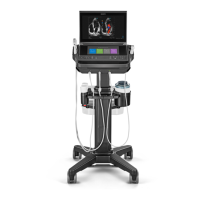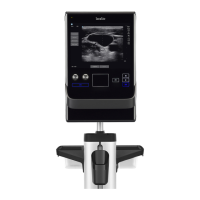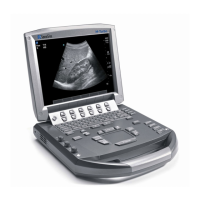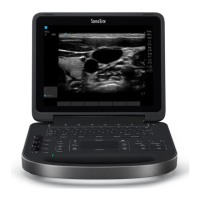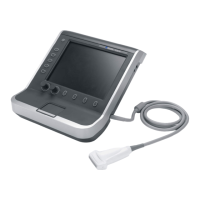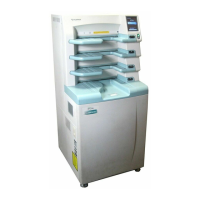




Do you have a question about the FujiFilm SONOSITE X-PORTE and is the answer not in the manual?
Lists resources for assistance, including visual guides, on-system help, service manuals, and technical support contacts.
Describes the SonoSite X-Porte as a portable device for acquiring and displaying high-resolution ultrasound images.
Instructions for powering on the system using AC power or the internal battery.
Details the layout and information displayed on the clinical monitor during exams.
Explains how to interact with the touch panel using various gestures like swipe, drag, and tap.
Step-by-step instructions for connecting transducers to the system, with or without the TTC.
Guides users on choosing the correct transducer and exam type for optimal diagnostic capability.
Configures system security, user login, and password management for patient information protection.
Details security settings to meet HIPAA requirements for electronic protected health information.
Instructions for logging in as an administrator and changing the administrator password.
Options to require user login, hide patient information, and disable export of patient data.
Procedures for logging in as a user or guest, and changing user passwords.
Specifies system location, storage alerts, and manages wireless certificates and DICOM settings.
Explains DICOM standard usage for data transfer, import, and export.
Tasks for configuring the system for DICOM transfer, typically done by network administrators.
Instructions for connecting the system to the network via Ethernet or wirelessly.
Details on configuring DICOM pages for locations, archives, printers, and servers.
Manages general preferences, brightness, labels, exam types, and user profile settings.
Specifies system startup mode, automatic worklist query, and footswitch programming.
Describes the four main imaging modes: 2D, Color, Doppler, and M Mode.
Explains how to adjust image parameters, labels, and zoom using controls bar and more controls.
Covers freezing the image, viewing the cine buffer, and zooming for detailed analysis.
Information on using Needle Profiling for needle guidance during procedures.
Guides on entering patient identification, exam, and clinical details for the report.
Details on archiving exams to DICOM servers and exporting exams to USB memory sticks.
Explains how to record video to a USB memory stick via the DVR USB port.
Describes the ECG feature, available only on the cardiac exam type.
Provides information on different types of measurements and how to perform them.
Explains how to assign performed measurements to calculations for saving results.
Discusses performing calculations and saving results to the patient report.
Details calculations for arterial exams, including ICA/CCA ratio and volume flow.
Lists calculations for cardiac exams, such as EF, FAC, and LV Mass.
Guides on calculating gestational age, fetal heart rate, and blood flow velocities.
Details calculations for the Acute Care feature, applicable to any exam type.
Details measurement accuracy and range for 2D and M Mode, including system tolerance.
Provides solutions for common system issues like failure to turn on or poor image quality.
Explains the use of license keys for software activation and operation.
Details routine maintenance, cleaning, and disinfecting procedures.
Recommends backing up patient data and system configuration settings to prevent data loss.
Procedures for preparing the system for service, including data export and setting preservation.
Uses Spaulding classifications to determine appropriate cleaning levels based on tissue contact.
Procedure for high-level cleaning and disinfection after contact with blood or bodily fluids.
Procedure for low-level cleaning and disinfection when no contact with bodily fluids occurs.
Guidelines for comfortable and effective use of the ultrasound system to prevent musculoskeletal disorders.
Information on the system's compliance with electrical safety standards and precautions.
Details the system's classification as Class I equipment and applied parts.
Procedure to completely remove power from the system by disconnecting power cord and switches.
Precautions to protect the system, transducer, and accessories from damage or injury.
General safety information related to clinical use, including transducer temperature and erratic behavior.
Information on the system's compliance with EMC limits for medical devices.
Lists accessories and peripherals tested for compliance with the ultrasound system.
Explains the ALARA principle for minimizing patient exposure to ultrasound energy.
Guides on how imaging modes and controls affect ultrasound output and ALARA principle application.
Identifies hazards and countermeasures for IT network failures.
Lists resources for assistance, including visual guides, on-system help, service manuals, and technical support contacts.
Describes the SonoSite X-Porte as a portable device for acquiring and displaying high-resolution ultrasound images.
Instructions for powering on the system using AC power or the internal battery.
Details the layout and information displayed on the clinical monitor during exams.
Explains how to interact with the touch panel using various gestures like swipe, drag, and tap.
Step-by-step instructions for connecting transducers to the system, with or without the TTC.
Guides users on choosing the correct transducer and exam type for optimal diagnostic capability.
Configures system security, user login, and password management for patient information protection.
Details security settings to meet HIPAA requirements for electronic protected health information.
Instructions for logging in as an administrator and changing the administrator password.
Options to require user login, hide patient information, and disable export of patient data.
Procedures for logging in as a user or guest, and changing user passwords.
Specifies system location, storage alerts, and manages wireless certificates and DICOM settings.
Explains DICOM standard usage for data transfer, import, and export.
Tasks for configuring the system for DICOM transfer, typically done by network administrators.
Instructions for connecting the system to the network via Ethernet or wirelessly.
Details on configuring DICOM pages for locations, archives, printers, and servers.
Manages general preferences, brightness, labels, exam types, and user profile settings.
Specifies system startup mode, automatic worklist query, and footswitch programming.
Describes the four main imaging modes: 2D, Color, Doppler, and M Mode.
Explains how to adjust image parameters, labels, and zoom using controls bar and more controls.
Covers freezing the image, viewing the cine buffer, and zooming for detailed analysis.
Information on using Needle Profiling for needle guidance during procedures.
Guides on entering patient identification, exam, and clinical details for the report.
Details on archiving exams to DICOM servers and exporting exams to USB memory sticks.
Explains how to record video to a USB memory stick via the DVR USB port.
Describes the ECG feature, available only on the cardiac exam type.
Provides information on different types of measurements and how to perform them.
Explains how to assign performed measurements to calculations for saving results.
Discusses performing calculations and saving results to the patient report.
Details calculations for arterial exams, including ICA/CCA ratio and volume flow.
Lists calculations for cardiac exams, such as EF, FAC, and LV Mass.
Guides on calculating gestational age, fetal heart rate, and blood flow velocities.
Details calculations for the Acute Care feature, applicable to any exam type.
Details measurement accuracy and range for 2D and M Mode, including system tolerance.
Provides solutions for common system issues like failure to turn on or poor image quality.
Explains the use of license keys for software activation and operation.
Details routine maintenance, cleaning, and disinfecting procedures.
Recommends backing up patient data and system configuration settings to prevent data loss.
Procedures for preparing the system for service, including data export and setting preservation.
Uses Spaulding classifications to determine appropriate cleaning levels based on tissue contact.
Procedure for high-level cleaning and disinfection after contact with blood or bodily fluids.
Procedure for low-level cleaning and disinfection when no contact with bodily fluids occurs.
Guidelines for comfortable and effective use of the ultrasound system to prevent musculoskeletal disorders.
Information on the system's compliance with electrical safety standards and precautions.
Details the system's classification as Class I equipment and applied parts.
Procedure to completely remove power from the system by disconnecting power cord and switches.
Precautions to protect the system, transducer, and accessories from damage or injury.
General safety information related to clinical use, including transducer temperature and erratic behavior.
Information on the system's compliance with EMC limits for medical devices.
Lists accessories and peripherals tested for compliance with the ultrasound system.
Explains the ALARA principle for minimizing patient exposure to ultrasound energy.
Guides on how imaging modes and controls affect ultrasound output and ALARA principle application.
Identifies hazards and countermeasures for IT network failures.
| Brand | FujiFilm |
|---|---|
| Model | SONOSITE X-PORTE |
| Category | Medical Equipment |
| Language | English |
